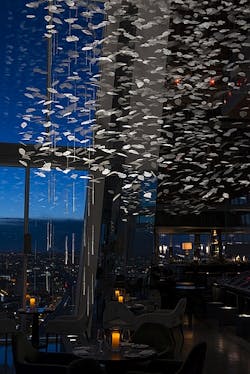LED lamps light unique nature sculpture in London restaurant
Light Projects LED fixtures using Soraa lamps, coupled with optical accessories, bring life to a leaf sculpture designed for the Aqua Shard restaurant.
Over the holiday season at the end of 2016 and into early 2017, the stylish Aqua Shard restaurant in London, located on the 31st floor of The Shard skyscraper, was home to an LED-illuminated suspended sculpture that was in part a different approach to a traditional Christmas tree. The lighting project utilized MentorLED Remote fixtures from Light Projects equipped with Soraa LED lamps to deliver uplight into a 9m-high cascading leaf sculpture called Human Nature. Timothy Hatton Architects designed the project, working with British naturalist Sir David Attenborough, and with the ultimate goal of benefitting Attenborough’s Flora & Fauna International charity. Lighting Design International assisted with the lighting design on the project.
Interested in articles & announcements on retail & hospitality lighting?
The 9m sculpture that hung in the three-story atrium of the restaurant was created using 3D printing technology. Leaves were created to represent five different British woodland tree types — English oak, silver birch, dogwood, wych elm, and field maple. The leaves were made of recycled plastic. During the day, the white leaves played counterpoint to the views of the London skyline. At night with the lights on and dimmed for effect, the leaves seemingly floated in space, casting gentle shadows on the ceiling.
The lighting design was based on the aforementioned MentorLED Remote spotlight fixtures that were mounted on specially constructed plinths attached to columns along the restaurant wall. Light Projects offers the luminaires with a number of different light source options and for the Human Nature sculpture, Soraa AR111 LED lamps were installed. The Soraa lamps are based on the company’s gallium-nitride-on-gallium nitride (GaN-on-GaN) LED technology and what it calls VP3 (violet-emission 3-phosphor). The three phosphors result in superior color rendering and have made Soraa a favorite of lighting designers working in hospitality applications, among other demanding applications including retail and museums.
Uplight delivered via MentorLED Remote fixtures and AR111 LED lamps is directed via Snap optical accessories that achieve the desired beam patterns for the Human Nature sculpture, which mimics British woodland trees. (Source: Timothy Hatton Architects.)
The height of the sculpture and the location of the fixtures required a mix of lamp types and optical accessories. Ultimately, there were 25°, 36°, and 60° lamps used in the project. Moreover, Soraa offers a range of optical accessories in its Snap line that magnetically attach to the lamps and snap into position. The design team utilized 10×25, 10×36, and 10×60 linear beam spreaders to deliver the required patterns.
Alas the project was only temporary, although we have beautiful photographs to remind us of what can be accomplished with LED sources and artistic creativity. And in the case of the Aqua Shard project, the deconstruction served a good cause. The individual leaves from the sculpture were sold as art pieces. And the money raised goes to Flora & Fauna.
The London project was certainly not the first time we have seen LED lighting used in projects where the lighting design was equal parts functional and artistic. In fact, such projects have been delivered indoors and out. A few years back in New York there was a temporary outdoor project in the Flatiron plaza. And, of course, LEDs are regularly being used to illuminate art in museum settings.

Maury Wright | Editor in Chief
Maury Wright is an electronics engineer turned technology journalist, who has focused specifically on the LED & Lighting industry for the past decade. Wright first wrote for LEDs Magazine as a contractor in 2010, and took over as Editor-in-Chief in 2012. He has broad experience in technology areas ranging from microprocessors to digital media to wireless networks that he gained over 30 years in the trade press. Wright has experience running global editorial operations, such as during his tenure as worldwide editorial director of EDN Magazine, and has been instrumental in launching publication websites going back to the earliest days of the Internet. Wright has won numerous industry awards, including multiple ASBPE national awards for B2B journalism excellence, and has received finalist recognition for LEDs Magazine in the FOLIO Eddie Awards. He received a BS in electrical engineering from Auburn University.





